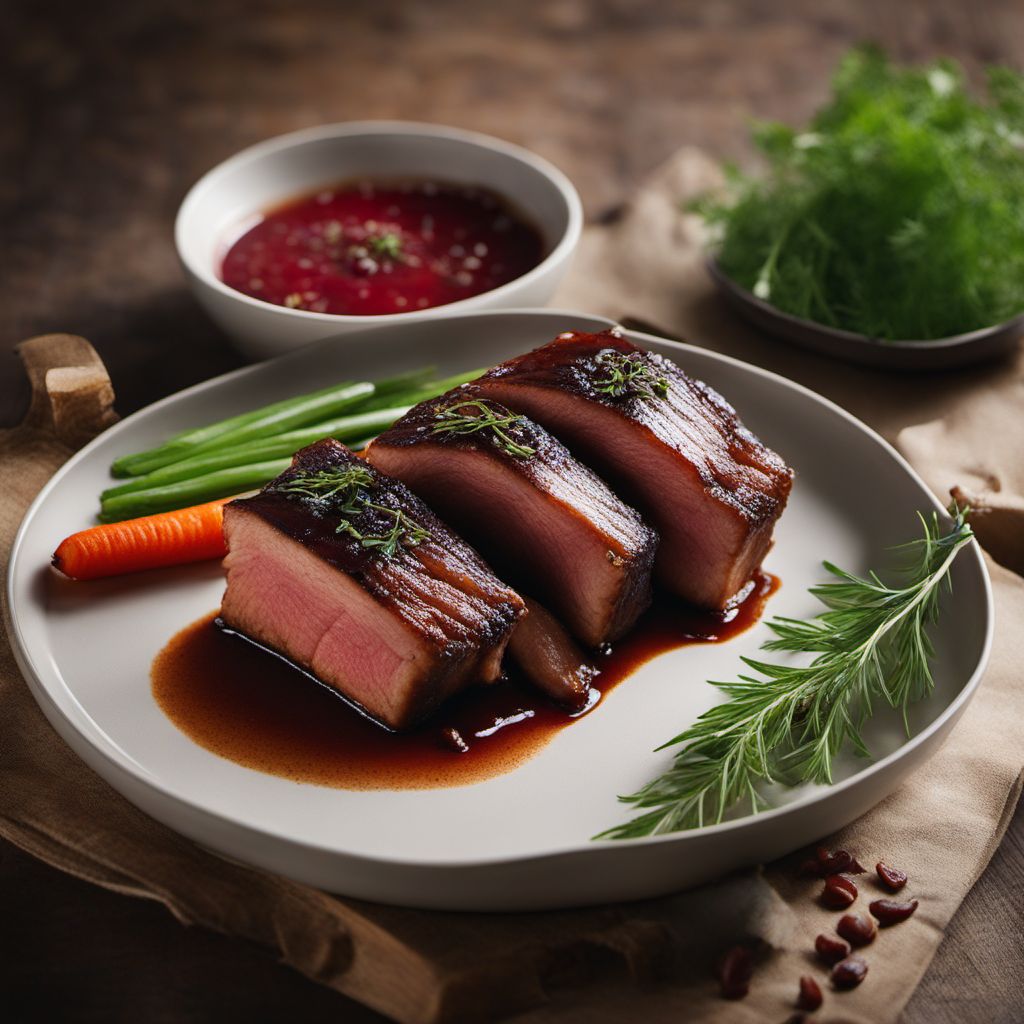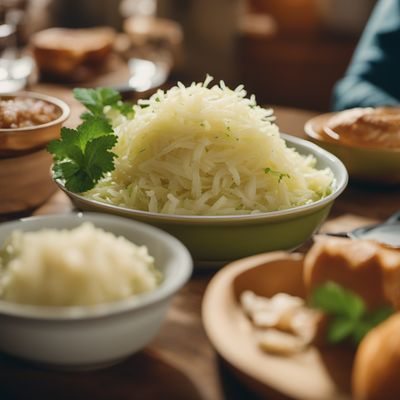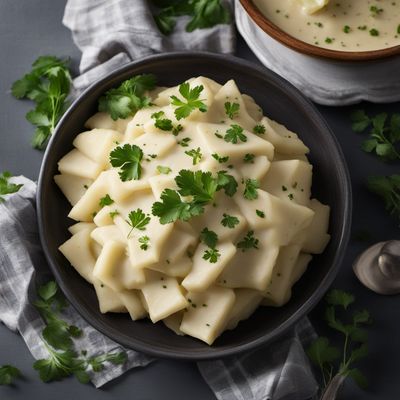
Recipe
German-style Braised Pork Belly (Schweinebauch)
Hearty German Pork Belly Stew: A Delightful Twist on Kakuni
4.5 out of 5
Indulge in the rich flavors of German cuisine with this delightful twist on the traditional Japanese dish, Kakuni. This German-style braised pork belly, known as Schweinebauch, combines tender meat with aromatic spices and a savory sauce, creating a comforting and satisfying meal.
Metadata
Preparation time
20 minutes
Cooking time
2.5 to 3 hours
Total time
3 to 3.5 hours
Yields
4 servings
Preparation difficulty
Medium
Suitable for
Omnivore, Low-carb, Keto, Paleo, Gluten-free
Allergens
Mustard, Celery
Not suitable for
Vegetarian, Vegan, Dairy-free, Nut-free, Egg-free
Ingredients
In this German adaptation of Kakuni, the traditional Japanese flavors are replaced with German spices and ingredients. The dish incorporates caraway seeds, juniper berries, and mustard, which are commonly used in German cuisine. Additionally, the cooking technique is adjusted to reflect the slow-braising method often employed in German cooking. We alse have the original recipe for Kakuni, so you can check it out.
-
1.5 kg (3.3 lbs) pork belly, skin-on 1.5 kg (3.3 lbs) pork belly, skin-on
-
2 tablespoons vegetable oil 2 tablespoons vegetable oil
-
2 onions, sliced 2 onions, sliced
-
4 cloves garlic, minced 4 cloves garlic, minced
-
2 carrots, sliced 2 carrots, sliced
-
2 celery stalks, sliced 2 celery stalks, sliced
-
2 tablespoons caraway seeds 2 tablespoons caraway seeds
-
4 juniper berries 4 juniper berries
-
2 bay leaves 2 bay leaves
-
500 ml (2 cups) beef broth 500 ml (2 cups) beef broth
-
250 ml (1 cup) red wine 250 ml (1 cup) red wine
-
2 tablespoons Dijon mustard 2 tablespoons Dijon mustard
-
Salt and pepper, to taste Salt and pepper, to taste
Nutrition
- Calories (kcal / KJ): 450 kcal / 1884 KJ
- Fat (total, saturated): 35g, 12g
- Carbohydrates (total, sugars): 2g, 1g
- Protein: 30g
- Fiber: 0g
- Salt: 1.5g
Preparation
-
1.Preheat the oven to 160°C (320°F).
-
2.Heat the vegetable oil in a large oven-safe pot over medium heat.
-
3.Add the pork belly, skin-side down, and cook until browned and crispy, about 5 minutes. Flip and brown the other side.
-
4.Remove the pork belly from the pot and set aside.
-
5.In the same pot, add the onions, garlic, carrots, and celery. Sauté until the vegetables are softened.
-
6.Add the caraway seeds, juniper berries, and bay leaves. Cook for another minute to release their flavors.
-
7.Return the pork belly to the pot, placing it on top of the vegetables.
-
8.Pour in the beef broth and red wine. Bring to a simmer.
-
9.Cover the pot and transfer it to the preheated oven. Braise for 2.5 to 3 hours, or until the pork belly is tender and easily pulls apart.
-
10.Remove the pot from the oven and carefully take out the pork belly. Set it aside to rest.
-
11.Strain the cooking liquid into a saucepan, discarding the solids. Place the saucepan over medium heat.
-
12.Stir in the Dijon mustard and simmer until the sauce has thickened slightly.
-
13.Season with salt and pepper to taste.
-
14.Slice the pork belly into thick pieces and serve with the sauce.
Treat your ingredients with care...
- Pork belly — Choose a piece with a good balance of meat and fat for the best texture and flavor.
- Caraway seeds — Toasting the caraway seeds before adding them to the dish will enhance their aroma.
- Juniper berries — Crush the juniper berries slightly to release their flavors.
Tips & Tricks
- For an extra layer of flavor, marinate the pork belly in the red wine and mustard mixture overnight before cooking.
- Serve the dish with traditional German sides like sauerkraut, mashed potatoes, or braised cabbage.
- If you prefer a thicker sauce, you can add a cornstarch slurry to the cooking liquid and simmer until thickened.
Serving advice
Serve the German-style Braised Pork Belly with a generous spoonful of the flavorful sauce on top. Accompany it with a side of sauerkraut and creamy mashed potatoes for a complete and satisfying meal.
Presentation advice
Arrange the sliced pork belly on a platter, drizzling the sauce over the top. Garnish with a sprinkle of fresh parsley or chives for a pop of color. Serve the sides in separate bowls or on the side of the plate for an appealing presentation.
More recipes...
For Kakuni
For Japanese cuisine » Browse all
More Japanese cuisine dishes » Browse all

Hakata ramen
Hakata-style Ramen Noodle Soup
Hakata ramen is a type of Japanese noodle soup that originated in the Hakata district of Fukuoka. It is made with thin, straight noodles and a...

Yokohama-Style Ramen
Yokohama-style ramen is a type of ramen that originated in Yokohama, Japan. It is a pork-based soup that is flavored with soy sauce and topped...

Kaisendon
Kaisendon is a Japanese rice bowl dish that is topped with various types of sashimi (raw fish) and other seafood. It is a popular dish in Japan...
More German cuisine dishes » Browse all

Nürnberger Lebkuchen
Nuremberg Lebkuchen
Nürnberger Lebkuchen is a traditional German gingerbread cookie that originated in the city of Nuremberg. It is a popular Christmas treat that is...

Bayerische Breze
Bayerische Breze is a traditional German pretzel that is typically served as a snack or appetizer. It is a type of soft pretzel that is made with...

Sauerkraut
Sauerkraut is a traditional German dish made with fermented cabbage.









